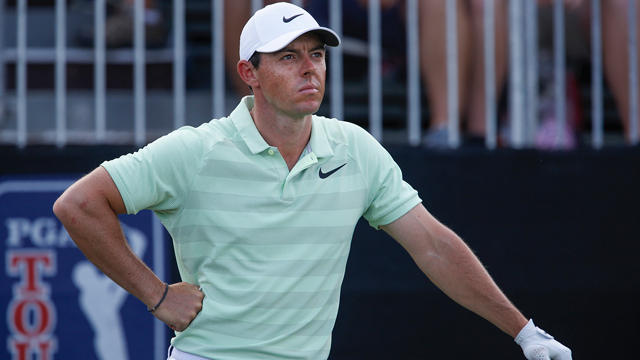NEWS
Rory McIlroy let his instincts take over with the putter at Bay Hill. Here's why you should, too.
By T.J. Auclair
Published on

Former world No. 1 Rory McIlroy has struggled mightily these past couple of years with his putter.
It was reported last week, however, that McIlroy sought some advice from Brad Faxon before the start of the Arnold Palmer Invitational. Faxon is regarded by many as one of the all-time great putters.
So what came of it? Let's just say McIlroy will likely be seeing/talking to Faxon far more frequently. And others might want to do the same.
McIlroy put on an absolute clinic at Bay Hill. He needed just 100 putts for the week and cruised to a three-stroke victory -- his first since the 2016 Tour Championship, which ended the same day that Palmer passed away.
We talked to 2013 PGA National Teacher of the Year Lou Guzzi to get insight into the differences he saw in McIlroy at Bay Hill.
"When you're learning a putting technique that will work for you, there are two things you need to focus on," Guzzi said. "The first is getting the ball started on the line you want to start it on and the second is to have great speed control. Rory had both those clicking at Bay Hill."
While we don't know everything Faxon and McIlroy discussed, a few of those things were mentioned on the telecast. First, McIlroy dropped his mallet putter in favor of the blade-style that won him four majors. Second, he wasn't as technical as he has been. Finally, and most importantly, he just let his instinct take over when he was ready to stroke the putter.
"Think about throwing a baseball or a football, or shooting a basketball," Guzzi said. "You learn a technique -- you're zoning in on your target and, without thinking, you get it there. In those sports you learn to execute even when you're getting hit or pushed. But sometimes, you fall into a slump. Instead of letting the instincts take over, you're wondering what it is you're doing wrong. And then you overthink. The same thing happens in golf."
Guzzi noticed the confidence in McIlroy's body language throughout the week and it seemed to grow with each putt he made.
With McIlroy, you can see when he's in the zone. There's a noticeable bounce in his step. His just is puffed out. His chin is high and he's smiling.
"Rory and his mannerisms where noticeable for sure," Guzzi said. "I think in the end you are what you think about. I remember reading a book where Gary Player talked about looking in the mirror and saying, 'you're the greatest player in the world, the greatest putter in the world, the healthiest golfer in the world.' Essentially, you are what you think about. That's going to affect your day. If you're feeling down, but your chin is high, chest is out and you're smiling, it will change your mood. If you apply that to your golf, it'll probably change the way you play. That's not to discount being prepared. You need to be prepared. But attitude is often overlooked."
Here's what Guzzi recommends to have more success on the greens:
1. Evaluate and visualize what you want the putt to do.
"Burn an image into your mind of what you want that putt to do," Guzzi said. "Ask yourself where you want the ball to enter the hole."
2. Be totally absorbed in the putt.
"When you're ready to move that putter back, the only thing on your mind is the image of the putt," he said. "Allow your stroke to respond to the image. Be totally absorbed in it. Allow your stroke to respond to the image. The visual of the putt will allow your stroke to go back and through as far as it needs to without thought. We don't think about how far back our arms go back and through to throw a baseball."
3. Keep your head still.
"A suggestion I have for most amateurs is to absolutely keep your head as still as possible until the putter completely stops," Guzzi said. "That will keep the ball from moving off its intended line."
So what makes a great putter? For Faxon, it's always been instinct and thinking about nothing but the putt at hand.
It reminded Guzzi a story about a member he used to have some gambling matches against.
"He was a barber. Frank the Barber," Guzzi said. "He had one of the worst putting strokes I had ever seen, but he made everything. For years. One day, I asked him, 'Frank, how do you putt so well? What do you do with your putting stroke?' He said, 'Here's all I can tell you. I hold it lightly and I see the putt before I hit it. Other than that, I have nothing for you.'
"He had no idea what his stroke did, but he made everything," Guzzi added. "The emphasis there is that he putted for money. He was a money player. It was pressure. That tells you a lot about absorbing yourself in the putt."
The putting, for McIlroy, was just part of his overall domination at Bay Hill.
Golf Channel stats man, Justin Ray, noted that "strokes gained putting" has been tracked on Tour since 2004. Over that time, only one player has won a tournament while leading the field in strokes gained putting, driving distance, proximity to the hole and scrambling.
That was McIlroy on Sunday.
"I personally think that the putting advice that Rory received from Faxon, he probably also applied to every other part of his game," Guzzi said. "I think they made a comment about Rory enjoying playing golf and having fun again. That's why we all got into the game -- to have fun."
And it sure has to be fun when you're playing video-game golf like McIlroy did.